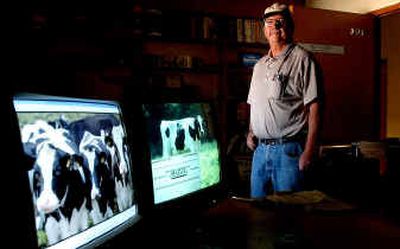An idea of udder simplicity

Sticking thermometers inside cows on his southern Idaho dairy farm used to take about 90 minutes a day, said farmer Clint Gentillon.
That’s not the case now that he’s added a new technology product on his family farm — called Udder Side Dairy — developed by Post Falls-based MagiiX, Inc.
“Instead of doing that temperature checking by hand, I can do it in about 10 minutes a day,” Gentillon said.
Len Wallace, the founder and sole employee of MagiiX, hopes to sell his product to dairy farmers from coast to coast. It uses radio-frequency signals sent from inside a cow to a nearby receiver. The receiver collects information on the cow’s temperature, a key aspect of managing herd health.
Farmers like Gentillon need to watch the temperatures of cows, especially in the first month after they’ve produced a calf. “If cows get sick, we have to treat them so they don’t stop producing milk,” he said. Any technology that can spot fevers or infection quickly is worth investigating, he said, which is why Udder Side Dairy invested in the product.
Traditionally, dairy farmers have checked a cow’s temperature by inserting a thermometer in the animal’s rectum. MagiiX uses a metallic bolus — a three-inch metal tube — that ends up in the cow’s rumen, which is one of its digestive chambers.
When the cow walks near a MagiiX-enabled receiver panel, the bolus transmits information. The data includes the cow’s temperature and its unique identification number. The data is recorded on a nearby computer.
Farmers already use radio-frequency tags to track animals. Those are mostly attached as ear tags, which Wallace said can come off or get lost as herds move around.
The bolus inside the cow remains in place and has no impact on the animal’s health since it only sends data when a radio signal is received from the nearby power panel, he said.
Wallace says the health of “fresh cows” — those who’ve calved and are producing milk — is just one use of the MagiiX product. Another is tracking the fertility, or estrus cycle, of cows.
“Our system should be able to detect more accurately the best time and day for insemination,” Wallace said. “I’ve been told by dairymen that for every day they wait too long, it costs them $3 a day, per cow.”
Wallace moved to Post Falls from Darby, Mont., in 2002. For several years he ran the largest elk farm in the country, creating a herd of nearly 1,110 animals, he said. He closed the controversial business after Montana passed a law preventing hunting elk on ranches.
During that period, Wallace said he learned about radio-frequency devices as a solution to tracking animals.
“I’ve spent about $1 million to develop the product,” he said. He expects to generate close to $600,000 in sales next year.
His main market is fairly obvious — the 9 million dairy cows in the United States and about 1.5 million in Canada. His first customers have been in southern Idaho and Montana. “I’d like to develop customers in western Washington. Washington has the highest dairy productivity of the entire country,” he said.
MagiiX relies on a Colorado company, Phase IV Engineering, to manufacture the bolus devices and the radio panel. Together, the two companies will divide the $35 they charge for each bolus and the $5,000 for the installation of the panel.
Another source of revenue will be offering a Web-tracking service, with the help of Key Communications of Coeur d’Alene, the firm that MagiiX uses to develop software to track animal information.
“If temperatures get high or out of ordinary, we’ll e-mail or contact the cell phone of the farmer, to give instant notification of the change in the cow’s temperature,” said Dean Batson, Key Communication’s director of operations.
Each MagiiX bolus is painted bright orange. “In case it doesn’t end up in the rumen and comes out in the cow piles, it’d be easy to find,” Wallace said. “We’ve done 1,100 animals so far, and that hasn’t happened yet,” he said.